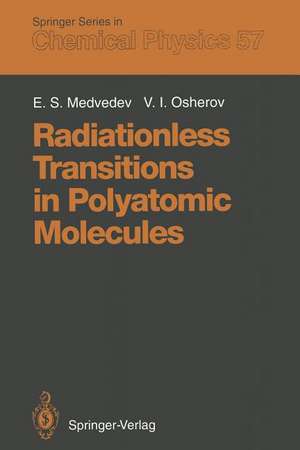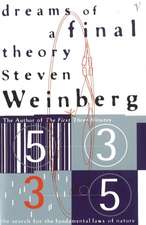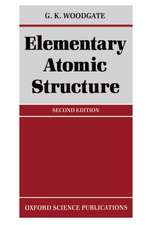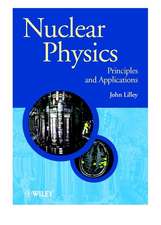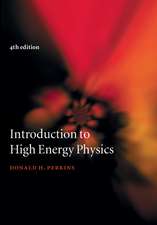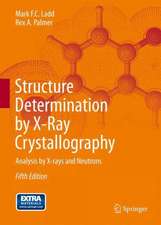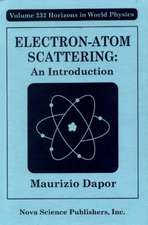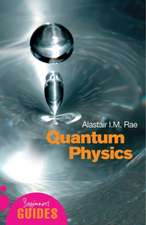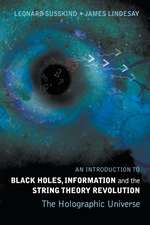Radiationless Transitions in Polyatomic Molecules: Springer Series in Chemical Physics, cartea 57
Autor Emile S. Medvedev, Vladimir I. Osheroven Limba Engleză Paperback – 11 ian 2012
Din seria Springer Series in Chemical Physics
- 20%
 Preț: 585.30 lei
Preț: 585.30 lei - 15%
 Preț: 643.00 lei
Preț: 643.00 lei - 15%
 Preț: 635.96 lei
Preț: 635.96 lei - 18%
 Preț: 953.03 lei
Preț: 953.03 lei - 15%
 Preț: 644.63 lei
Preț: 644.63 lei - 15%
 Preț: 638.43 lei
Preț: 638.43 lei - 15%
 Preț: 649.22 lei
Preț: 649.22 lei - 15%
 Preț: 647.40 lei
Preț: 647.40 lei - 15%
 Preț: 638.89 lei
Preț: 638.89 lei - 15%
 Preț: 652.31 lei
Preț: 652.31 lei - 15%
 Preț: 638.43 lei
Preț: 638.43 lei - 15%
 Preț: 637.13 lei
Preț: 637.13 lei - 18%
 Preț: 952.57 lei
Preț: 952.57 lei - 18%
 Preț: 947.85 lei
Preț: 947.85 lei - 15%
 Preț: 636.45 lei
Preț: 636.45 lei - 15%
 Preț: 649.87 lei
Preț: 649.87 lei - 18%
 Preț: 953.65 lei
Preț: 953.65 lei - 18%
 Preț: 894.03 lei
Preț: 894.03 lei - 15%
 Preț: 647.27 lei
Preț: 647.27 lei - 18%
 Preț: 1249.00 lei
Preț: 1249.00 lei - 15%
 Preț: 646.30 lei
Preț: 646.30 lei - 18%
 Preț: 954.14 lei
Preț: 954.14 lei - 24%
 Preț: 1226.82 lei
Preț: 1226.82 lei - 18%
 Preț: 961.72 lei
Preț: 961.72 lei - 18%
 Preț: 1002.31 lei
Preț: 1002.31 lei - 24%
 Preț: 647.25 lei
Preț: 647.25 lei - 18%
 Preț: 888.49 lei
Preț: 888.49 lei - 18%
 Preț: 908.04 lei
Preț: 908.04 lei - 15%
 Preț: 641.38 lei
Preț: 641.38 lei - 15%
 Preț: 585.40 lei
Preț: 585.40 lei - 15%
 Preț: 639.90 lei
Preț: 639.90 lei - 18%
 Preț: 897.02 lei
Preț: 897.02 lei
Preț: 644.82 lei
Preț vechi: 758.60 lei
-15% Nou
Puncte Express: 967
Preț estimativ în valută:
123.43€ • 134.11$ • 103.74£
123.43€ • 134.11$ • 103.74£
Carte tipărită la comandă
Livrare economică 21 aprilie-05 mai
Preluare comenzi: 021 569.72.76
Specificații
ISBN-13: 9783642851117
ISBN-10: 3642851118
Pagini: 388
Ilustrații: X, 374 p.
Dimensiuni: 155 x 235 x 20 mm
Greutate: 0.54 kg
Ediția:Softcover reprint of the original 1st ed. 1995
Editura: Springer Berlin, Heidelberg
Colecția Springer
Seria Springer Series in Chemical Physics
Locul publicării:Berlin, Heidelberg, Germany
ISBN-10: 3642851118
Pagini: 388
Ilustrații: X, 374 p.
Dimensiuni: 155 x 235 x 20 mm
Greutate: 0.54 kg
Ediția:Softcover reprint of the original 1st ed. 1995
Editura: Springer Berlin, Heidelberg
Colecția Springer
Seria Springer Series in Chemical Physics
Locul publicării:Berlin, Heidelberg, Germany
Public țintă
ResearchCuprins
1. Introduction.- 2. Qualitative Theory of Radiationless Transitions.- 2.1 Balance Equation.- 2.2 Experimental Observations and Empirical Rules.- 2.3 Molecular Energy Level Model.- 2.4 Physical Nature of Radiationless Transitions.- 2.5 General Description of Luminescence Kinetics: Intermediate Case and Statistical Limit.- 2.6 Strong-Coupling Limit.- 2.7 Weak-Coupling Limit.- 2.8 Time-Dependent Perturbation Theory.- 2.9 Comparison of Various Expressions for the Transition Rate.- 2.10 Characterization of the Final States of an Isolated Molecule.- 2.11 Small, Large and Intermediate Molecules.- 3. Luminescence Intensity as a Function of Time and the Radiationless Transition Rate.- 3.1 Formulation of the Problem.- 3.2 Laplace Transformation, Green’s Functions and Resonant States.- 3.3 Computation of the Green’s Functions.- 3.4 Evolution of the Initial State and the Luminescence Intensity.- 3.5 Resonant States.- 3.6 Method of Projection Operators.- 4. Matrix Elements of Intramolecular Interactions.- 4.1 Adiabatic Approximation.- 4.2 Accuracy of the Adiabatic Approximation.- 4.3 Crude Adiabatic Approximation.- 4.4 Coupling Operators.- 4.5 Condon Approximation.- 4.6 Model of Noninteracting Oscillators.- 4.7 Mechanisms and Selection Rules for Radiationless Transitions.- 4.8 Overlap Integrals for Harmonic and Morse Oscillators.- 5. Quasiclassical Methods.- 5.1 Introductory Remarks.- 5.2 Overlap Integral for a Harmonic Oscillator.- 5.3 Overlap Integral for an Anharmonic Oscillator.- 5.4 Franck-Condon Principle for Radiationless Transitions.- 5.5 Transitions Between Parallel Terms.- 5.6 Overtone Vibrational Transitions.- 5.7 Collision Model.- 5.8 Two-State Vibronic Levels.- 6. The Statistical Limit.- 6.1 Accepting Modes, Effective States and the Transition Rate.- 6.2Generating-Function Method.- 6.3 Saddle-Point Method.- 6.4 Single Vibronic Level (SVL) Transition-Rate Dependence upon Initial Vibrational Energy.- 6.5 Transition Rate from Statistically Equilibrated Initial States.- 6.6 Summation of the Franck-Condon Factors.- 6.7 Inductive-Resonant-Transfer Mechanism.- 7. The Intermediate Case.- 7.1 Physical Effects.- 7.2 Correlation-Function Method.- 7.3 Kinetic Model.- 8. Conclusion.- Appendix. Commutation Rules for Angular Momentum in the Laboratory and Molecular Frame.- References.
